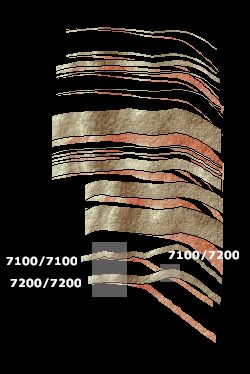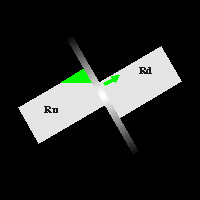 | |||
Seal Behavior Fault plane profiles allow you to infer the sealing behavior of faults in producing fields. Seal behavior is inferred from hydrocarbon contacts and pressure data as well as several types of fault dependent leak points. This same procedure can be used to predict seal behavior and hydrocarbon column heights in untested prospects. Here are some examples. | This is a sample |
| |
Cross Sealing Fault: Example This is a detail of the preceding FPP (right) showing a cross sealing juxtaposition. The 7100/7200 Sand juxtaposition (extreme right) places the hydrocarbon bearing 7200 Sand against the water-wet 7100 Sand. This juxtaposition is cross sealing.
| Seal/Leak Identification In the preceding FPP of Fault W there are numerous cross sealing & cross leaking juxtapositions. Here are two examples. | |||
| Cross Leaking Fault: Example This is a detail of the preceding FPP showing a cross leaking juxtaposition. The 7100/7100 Sand juxtaposition has a common GWC. Similarly the 7200/7200 Sand juxtaposition has both a common GWC and GOC. This is evidence of cross leakage at both sand/sand juxtapositions. One leaks gas; the other leaks both oil and gas. Calibration of SGR Threshold To calibrate the SGR threshold for seal/leak, the SGR is calculated for this and many other sand/sand juxtapositions. In this example, the SGR for the leaking juxtaposition is very high. The SGR's for the sealing juxtapositions are very low. Defining this seal/leak threshold allows you to predict the seal behavior of untested prospects.
|
| |||
| Fault Dependent Leak Points Seal behavior can also be inferred from several different types of fault dependent leak points. If a fault leaks at a sand/sand juxtaposition, hydrocarbon may be trapped only where sand/shale juxtaposition exists. At the leaking sand/sand juxtaposition hydrocarbons are free to migrate updip.
In this example (right) the OWC coincides with the top of the sand in the hanging-wall. The fault is cross leaking.
This type of fault dependent leak point is called a Juxtaposed Lithology Leak Point. It is an extremely common type that controls the spill points for many fields. If this were a prospect and you were able to predict cross leakage from quantitative fault seal analysis, you could have predicted the percent fill and hydrocarbon column heights. If the fault cross sealed, the hydrocarbon column height could be much greater. Identifying cross sealing faults can lead to new plays that do not require structurally independent closure. Large columns are trapped downdip of known fields and dry holes.
|
|
| For further information or to schedule a SEALS course CONTACT
|

